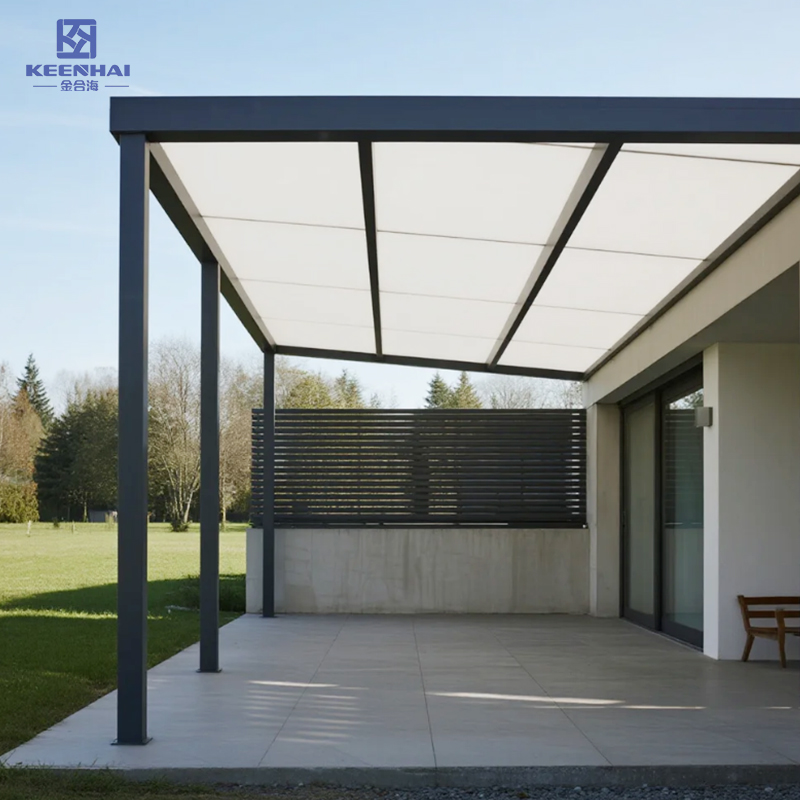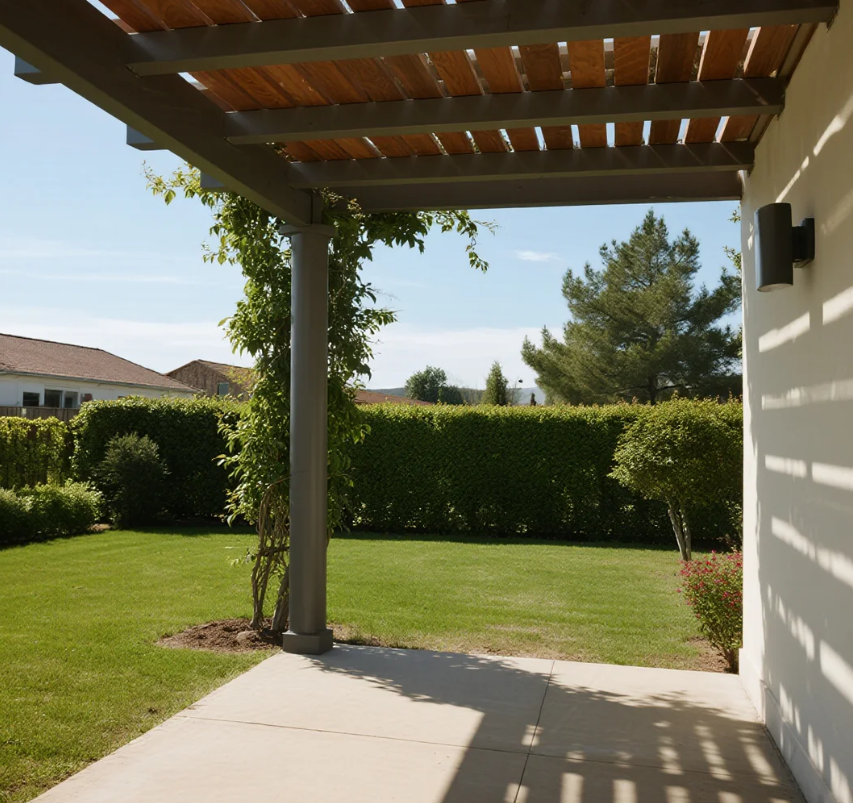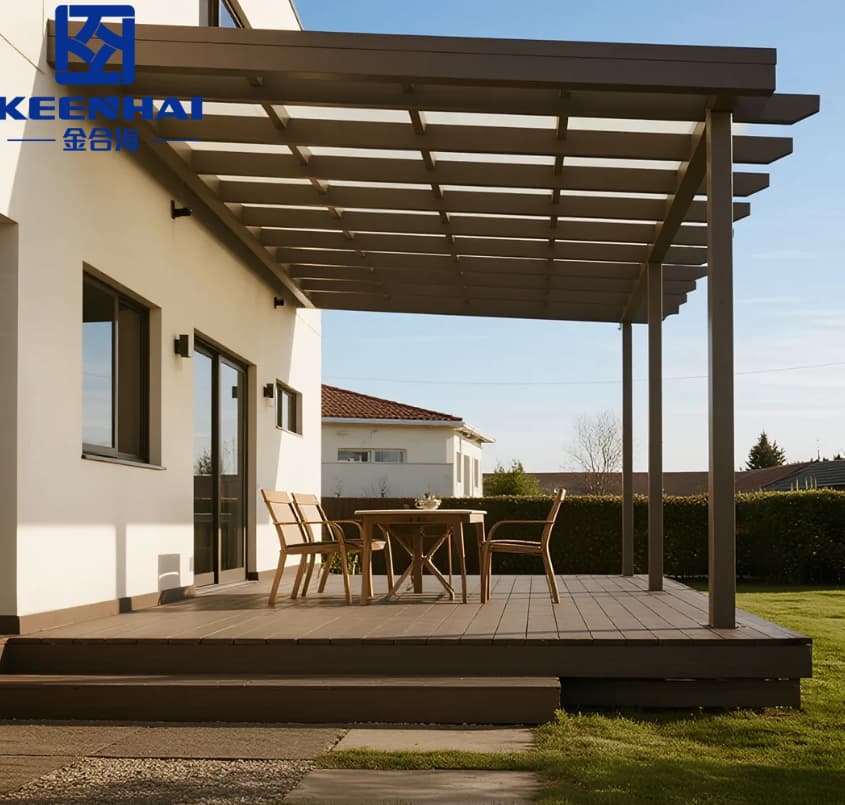
1. Durability and Longevity
1.1 Resistance to Rot, Warping, and Termites
Wooden pergolas are highly vulnerable to decay, especially in humid or coastal regions where moisture accelerates rot. Termites and carpenter ants also see wood as an easy target. By contrast, an Aluminum Pergola is completely immune to pests and will not warp, crack, or splinter over time. In a residential project in Miami, where year-round humidity is a challenge, homeowners reported that their aluminum structure looked brand new even after seven years, while a neighboring wooden pergola had already developed cracks and visible termite damage within three.
1.2 Performance in Different Weather Conditions
Aluminum performs consistently across a wide range of climates. In hot desert areas like Arizona, wood tends to dry out and split, while aluminum maintains its shape and finish. In colder northern regions, wooden beams often absorb moisture and expand, leading to warping when temperatures drop below freezing. Powder-coated aluminum remains stable and does not absorb water, which means no swelling or shrinking. Homeowners who installed aluminum pergolas in snowy Colorado backyards noted that the structure easily handled heavy snow loads without bending, something a cedar pergola of the same size failed to achieve.
1.3 Expected Lifespan of Aluminum vs Wood Pergolas
On average, a treated wooden pergola lasts about 10 to 15 years before major repairs or replacement are needed. Aluminum options typically exceed 20 years with only minimal upkeep, making them a better investment for long-term property value.
| Feature | Aluminum Pergola | Wood Pergola |
|---|---|---|
| Resistance to Rot | Yes | No |
| Pest Protection | Complete | Vulnerable |
| Average Lifespan | 20–25 years | 10–15 years |
| Weather Stability | High | Low–Medium |
| Maintenance Needs | Minimal | Regular sealing, staining, repairs |
This clear difference shows why many modern homeowners and commercial projects—such as outdoor dining areas in hotels or shaded seating in public parks—choose aluminum instead of traditional wood when durability and longevity are top priorities.

2. Maintenance Requirements
2.1 Cleaning and Upkeep for Aluminum Pergolas
Keeping an aluminum pergola looking sharp is simple. Most homeowners only need to rinse it with a garden hose a few times a year. For areas with heavy dust or pollen, a soft sponge and mild soap are enough to restore the finish. If you want a step-by-step routine that works well in residential backyards or restaurant patios:
-
Rinse the frame with clean water to remove loose dirt.
-
Mix mild soap with warm water, then wipe the surfaces with a sponge or microfiber cloth.
-
Rinse again thoroughly, making sure no soap residue remains.
-
Dry with a towel if you want to avoid water spots on darker finishes.
This entire process usually takes less than 20 minutes for an average-size structure, which is why so many homeowners choose aluminum when they want low-maintenance outdoor living.
2.2 Common Maintenance Challenges with Wood Pergolas
Wood requires a completely different level of attention. Every one to two years, you need to re-stain or re-seal the beams to protect them from moisture. If you live in a humid region, mildew and mold become recurring issues. In coastal cities like Tampa, salt in the air accelerates wood deterioration, forcing homeowners to sand down surfaces more often. Termite inspections are also a must because infestations can spread quickly and compromise the structure. Missing just one season of maintenance can cut the lifespan of a wooden pergola dramatically.
2.3 Long-Term Cost of Maintenance
When you compare upkeep costs over a 10-year period, the difference becomes obvious. Aluminum structures typically only require occasional cleaning supplies, while wood demands regular purchases of sealants, stains, and pest treatments. Labor adds up too, since sealing and sanding can take several hours each year.
| Category | Aluminum Pergola | Wood Pergola |
|---|---|---|
| Annual Cleaning Time | 1–2 hours | 10–15 hours |
| Maintenance Products | Soap and water | Stain, sealant, pest control |
| Average 10-Year Cost | Under $200 | $1,500–$3,000 |
Commercial projects like outdoor cafés or hotel pool decks often calculate these numbers before choosing a material. Once they see how much lower the ongoing costs are with aluminum, the decision becomes very straightforward.

3. Design and Customization Options
3.1 Color Finishes and Powder Coating Benefits
One of the biggest advantages of aluminum structures is the variety of finishes. Unlike wood, which typically comes in natural tones or stains, aluminum can be powder-coated in almost any color. Powder coating not only adds aesthetic appeal but also provides a protective layer against scratches, fading, and corrosion. For example, a homeowner in California wanted a pergola to match the trim of their modern home. With powder-coated aluminum, they selected a sleek charcoal finish that stayed vibrant even after years of direct sunlight exposure.
3.2 Modern vs Classic Aesthetic Appeal
Aluminum is incredibly versatile when it comes to style. For modern homes, it can be built with sharp lines and minimalist frames that complement contemporary architecture. In contrast, for more traditional spaces, aluminum can be designed with decorative beams that mimic the warmth of wood. Hotels often choose a Aluminum Modern Gazebo for poolside areas because it offers a clean, upscale look while still delivering shade and comfort. On the other hand, suburban homeowners might prefer a more classic design with cross beams that blend into a garden setting.
3.3 Flexibility in Shape, Size, and Accessories
Aluminum structures are not limited to a few standard shapes. They can be customized to fit small patios or large commercial courtyards. Builders often design extended models for restaurants that want to cover outdoor seating areas, while compact versions are perfect for private decks. Accessories also expand the options:
-
Motorized louvers allow you to adjust sunlight with a remote control.
-
Integrated LED lighting transforms the pergola into a nighttime entertainment space.
-
Retractable side screens offer privacy and wind protection.
-
Heating elements extend usability into colder months.
In residential projects, some families choose an Aluminum Pergola House to create a semi-enclosed backyard living room, adding value to the property while making the space usable year-round.

4. Cost Considerations
4.1 Initial Installation Costs
When comparing aluminum pergolas with traditional wood, the upfront costs are not always the same. Aluminum pergolas often have a higher initial price tag because of their durable materials, powder coating, and sometimes motorized louver systems. To break it down:
-
Material purchase – Aluminum profiles with protective finishes typically cost more than raw wood beams.
-
Labor expenses – Professional installation is usually required for aluminum structures, while some homeowners attempt DIY setups with wood.
-
Extra features – If you include add-ons such as lighting, motorized louvers, or drainage systems, the installation price can climb further.
Although wood might look cheaper in the beginning, these savings are temporary because maintenance quickly adds up.
4.2 Long-Term Value and ROI
Over time, aluminum pergolas generate a better return on investment compared to wood. The key reason is durability and reduced maintenance:
-
Aluminum does not rot, warp, or attract termites.
-
The protective powder coating prevents fading and corrosion.
-
Homeowners save significantly on repainting, sealing, or replacing damaged panels.
Think of it this way: the money saved on upkeep within the first 5–10 years often balances the higher upfront cost. This makes aluminum pergolas more valuable for property owners who want a structure that lasts decades with minimal attention.
4.3 Energy-Saving Features and Add-Ons
Modern aluminum pergolas often come with smart design elements that contribute to energy savings and daily comfort. For example:
-
Motorized louvers – Adjust the angle of the slats to block direct sun in the summer, keeping patio spaces cooler and reducing indoor cooling costs.
-
Insulated panels – Some models include thermal barriers that reflect heat and lower the temperature under the pergola.
-
Integrated lighting and fans – Built-in LED systems and ceiling fans reduce the need for additional outdoor fixtures, cutting electricity use.
Because of these innovations, aluminum pergolas are not just a shading solution—they act as an investment in both lifestyle and energy efficiency.
